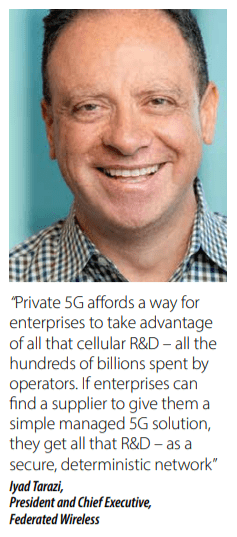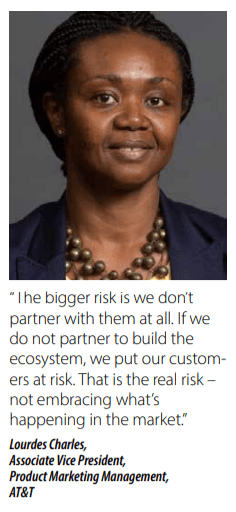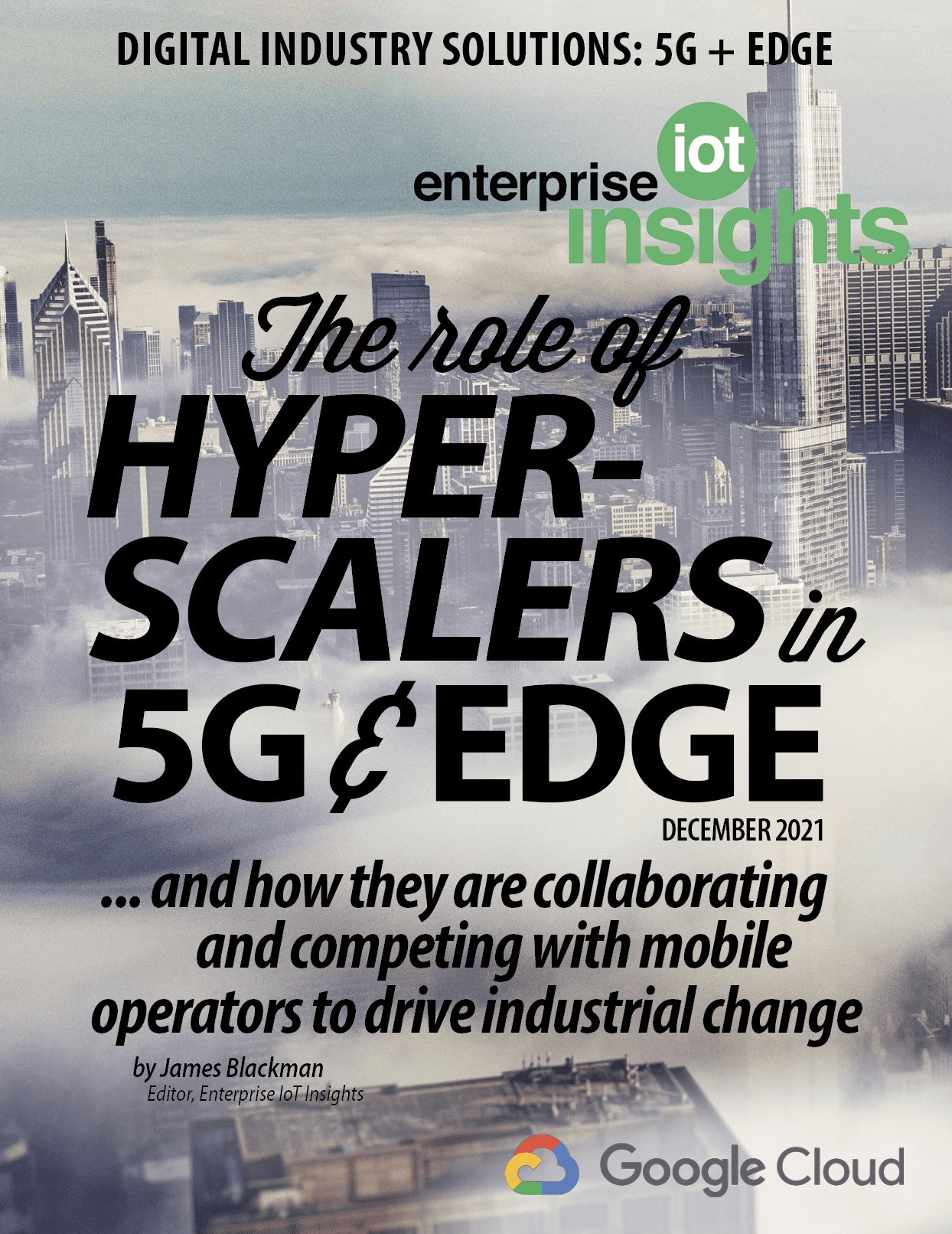Note, this is an excerpt from a new editorial report, The Role of Hyperscalers in 5G and Edge – and how they are Collaborating and Competing with Mobile Operators at the Industrial Edge. The report is free to download, and available here – or by clicking on the cover image at the bottom of the page.
There is a sense it is different for telcos this time, especially with private 5G; that the 4G story was about a one-trick consumer app-play over-the-top of the cellular network, and that 5G pulls all-ways underneath as a deterministic control infrastructure for new industrial workloads. We will come back to the application environment on top of the tech stack. The point is only that there are a wide range of enterprise-edge use cases developing on the access side, particularly in business- and mission-critical operations, that make 5G a key control function in their transformation.
“The network is the glue,” says Lourdes Charles, associate vice president at AT&T, handling the US carrier’s 5G and MEC portfolio, along with its private networks business, speaking on a webinar session with Enterprise IoT Insights sister-publication RCR Wireless this month (December). “[Other] components will not work independently of the network; they won’t meet the customer needs [without it]. So operators are the first choice for customers [to deliver] those types of solutions – to pull in all of those other partners to meet their needs.”
Maybe so; but 5G is not the engine in this change-machine; its inventors are not at the wheel, says at least a part of the market. “The momentum is enterprise-driven – and edge-compute driven,” says yad Tarazi, president and chief executive at Federated Wireless. “It is not carrier-driven.” Worse, it is not even carrier-owned, necessarily. It used to be that licensing regimes kept cellular in check with national operators. Not any more; not at the far edge, where regulatory moves on spectrum say anyone can be a carrier, and network disaggregation says anyone can be an operator.
Tarazi comments: “Private 5G affords a way for enterprises to take advantage of all that cellular R&D – all the hundreds of billions spent by operators. If enterprises can find a supplier to give them a simple managed 5G solution, they get all that R&D – as a secure, deterministic network to automate operations and processes. They can bring all those solutions under their control without incurring any of the complexity that comes with running a 5G network.”
 Which sounds rather like a free-for-all in the new 5G party wing of the 3GPP house, where the word is out, the doors are swinging open, and the hyperscalers are crashing in – most noisily, 18 months ago, when Microsoft rocked up with Affirmed Networks on one arm and Metaswitch on the other, and most recently, this month (December), when AWS appeared mob-handed with a strange entourage and ‘all the right moves’ (it implied), to lead its own 5G dance with enterprises.
Which sounds rather like a free-for-all in the new 5G party wing of the 3GPP house, where the word is out, the doors are swinging open, and the hyperscalers are crashing in – most noisily, 18 months ago, when Microsoft rocked up with Affirmed Networks on one arm and Metaswitch on the other, and most recently, this month (December), when AWS appeared mob-handed with a strange entourage and ‘all the right moves’ (it implied), to lead its own 5G dance with enterprises.
Alarm bells are ringing. The new AWS offer (see page 24), for example, pulls together telco parts from unnamed partners as a newage plug-and-play enterprise 5G system. It is a mainstream offer; the kind of highly-tuned control and automation desired by smart factories, and mission critical operations, are probably out of its reach (and not discussed further in this article). But the mass market is clearly in its sights, as private LTE gathers pace in the CBRS band in the US, and turns into private 5G in 2022.
Reflecting on the launch (see pages 22-24), Pablo Tomasi, principal analyst for private networks at Omdia, remarks: “The operators should know by now they are not the only ones – nor necessarily the best ones to drive private networks… It has significant implications for the market; it reiterates that hyperscalers are companies to watch for, as they understand 5G is not about connectivity per se but the digitization it enables.”
Haysom raises this flat-Earther philosophy again. “AWS is stressing a partnership approach. But it will be AWS in the minds andon the bills of customers. Which will be hard for telcos to take. They may get pushed back into more complex and niche deployments. But the focus for AWS is compute, storage, and networking; it is not an applications company, so the launch offers headroom for others to create solutions that meet specific needs,” he says.
It might not be an applications company, as Microsoft is with enterprises and Google is with consumers (and vice versa, to a lesser degree), but it is part of the biggest shopkeeper in the world, selling “elastic” (EC2) compute as a platform for digital change, with a fresh shipment of branded private 5G on its shelves. “AWS is an ecosystem play; it is a marketplace,” says Tarazi. “It has been signing-up hundreds, if not thousands, of partners over the last couple of years to be part of its ecosystem.”
The irresistible pull for the new breed of 5G cloud core and 5G open RAN merchants, is out-of-this-world market exposure and out-of-the-box system integration, he says. “It means two things for its partners: firstly, their solutions can be bought and sold within the AWS transaction system; secondly, their solutions are integrated into its edge and cloud servers.” So connectivity becomes an application in the AWS ecosystem, or whatever-ecosystem?
“You got it,” responds Tarazi. “That’s the most efficient way it’s going to work. It’s part of this process to move everything – whether it’s spectrum software like we provide or private wireless – to be cloud-native on Kubernetes, or the equivalent, to be managed on compute resources. That is the movement we’re all part of; that is the relationship that we value. That is where the industry is going.”
Just to clarify; what is Google Cloud’s strategy with private 5G in ‘vertical’ or shared spectrum? Would Google Cloud ever consider either acquiring or partnering-with a telco outfit to deliver its own 5G offering? “I’ll answer by reinforcing our strategy over the last couple of years, which is about partnership,” responds Abella, speaking on the same RCR Wireless webinar. “We want to partner with the CSPs in this endeavour. We don’t want to necessarily buy other equipment vendors, or go up against the CSPs. Because it’s about partnership – to build something better for the end customer. That’s our strategy – (to be) partner-led and partner-delivered.”
Partnership is a funny thing, of course; as Haysom notes above, AWS is talking a good game about it, as well, even though it is likely to butt-up against operators on the factory floor. Is there a risk for them, generally? Are operators approaching these MEC engagements with hesitancy and caution, as (certain) hyperscalers look to take charge of the private on-site 5G componentry, either in opportune circumstances or wherever they can?
“The bigger risk is we don’t partner with them at all,” says Charles at AT&T, restating that the two sides remain generally engaged in complementary disciplines at most points along the cloud-edge continuum. “If we do not partner to build the ecosystem, we put our customers at risk. That is the real risk – not embracing what’s happening in the market,” she says.
 What about others? How do Verizon and Vodafone, as prime movers in the enterprise 5G space, perceive the risk from hyperscalers? “It’s not black-and-white; these are not simple relationships,” responds Matthew Threefoot, director of edge platforms at Verizon.
What about others? How do Verizon and Vodafone, as prime movers in the enterprise 5G space, perceive the risk from hyperscalers? “It’s not black-and-white; these are not simple relationships,” responds Matthew Threefoot, director of edge platforms at Verizon.
He explains: “As networks become more virtualized and clouds become more distributed, there is that fine line, where there is some overlap. Microsoft is obviously looking at different networking technologies, and we realize that. But right now it is a partnership; it’s this whole ‘coopetition’ thing, where we are working together to advance the edge ecosystem.”
Vodafone says the same, essentially. “At times we’re working together to deliver something for a customer, and at times we’re working apart – and competing with each other. That is the nature of the ecosystem, for sure. You just need to be really conscious of the use cases you’re cooperating on, and the use cases you’re competing on,” comments Jennifer Didoni, head of cloud portfolio management in the cloud and security unit at Vodafone Business.
Note, this is an excerpt from a new editorial report, The Role of Hyperscalers in 5G and Edge – and how they are Collaborating and Competing with Mobile Operators at the Industrial Edge. The report is free to download, and available here – or by clicking on the cover image below.


